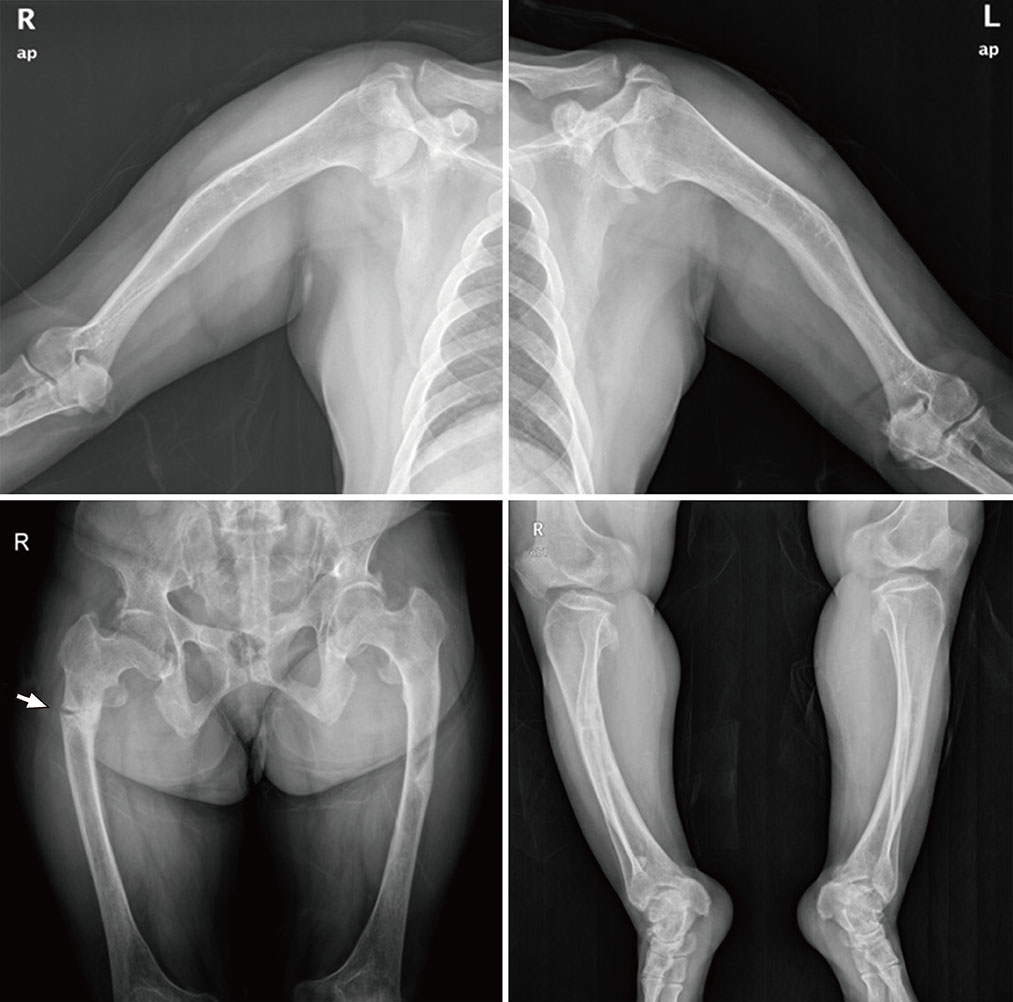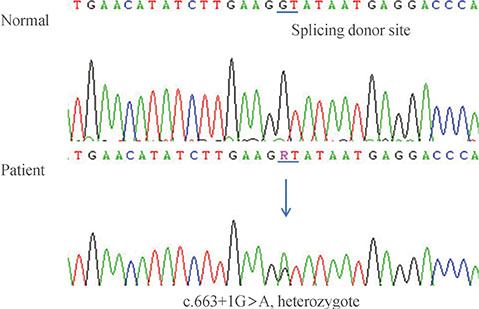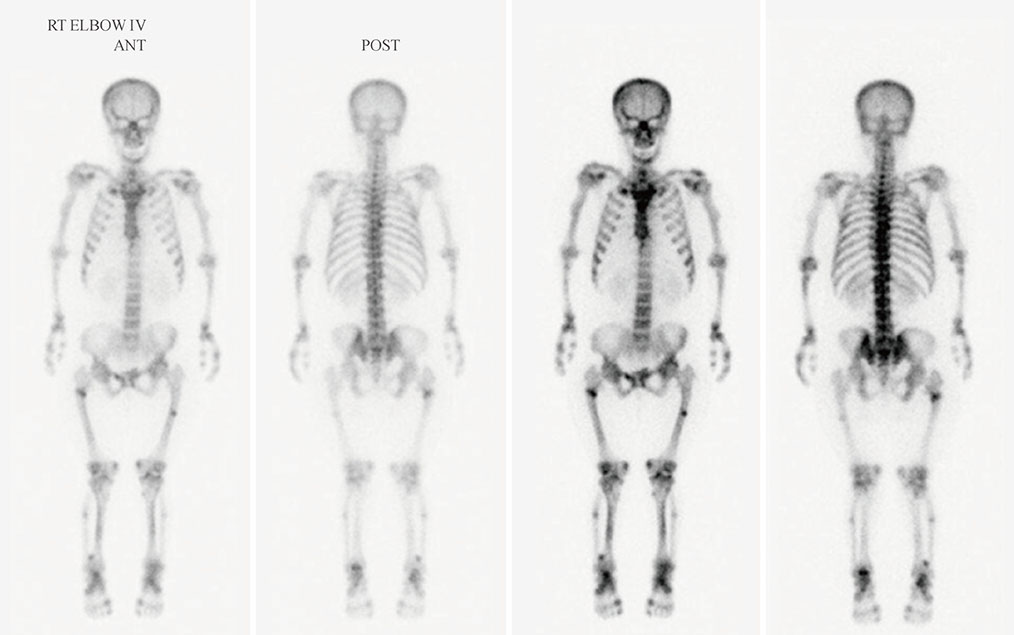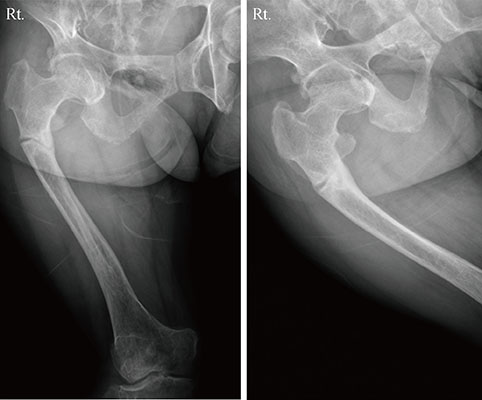A Novel PHEX Gene Mutation in a Patient with Sporadic Hypophosphatemic Rickets
- Affiliations
-
- 1Research Center for Endocrine and Metabolic Diseases, Department of Internal Medicine, Chungnam National University School of Medicine, Daejeon, Korea. kunsunkim@naver.com
- 2Department of Internal Medicine, Kyungpook National University Hospital, Daegu, Korea.
- KMID: 2169427
- DOI: http://doi.org/10.3803/EnM.2014.29.2.195
Abstract
- Phosphate regulating gene with homologies to endopeptidases on the X-chromosome (PHEX) is a common cause of X-linked hypophosphatemic (XLH) rickets. Diverse PHEX gene mutations have been reported; however, gene mutations in sporadic rickets are less common than in XLH rickets. Herein, we describe a 50-year-old female patient with sporadic hypophosphatemic rickets harboring a novel splicing-site mutation in the PHEX gene (c.663+1G>A) at the exon 5-intron 5 boundary. The patient had recently suffered from right thigh pain and an aggravated waddling gait. She also presented with very short stature, generalized bone pain, and muscle weakness. Despite low serum phosphate levels, her phosphate reabsorption rate was lower than normal. Additionally, her 1,25-dihydroxyvitamin D3 concentration was lower than normal, although FGF23 level was normal. After treatment with alfacalcidol and elemental phosphate, her rachitic symptoms subsided, and callus formation was observed in the fracture site on the right femur.
Keyword
MeSH Terms
Figure
Cited by 3 articles
-
A novel
de novo mosaic mutation inPHEX in a Korean patient with hypophosphatemic rickets
Misun Yang, Jinsup Kim, Aram Yang, Jahyun Jang, Tae Yeon Jeon, Sung Yoon Cho, Dong-Kyu Jin
Ann Pediatr Endocrinol Metab. 2018;23(4):229-234. doi: 10.6065/apem.2018.23.4.229.Identification of a novel variant in the
PHEX gene using targeted gene panel sequencing in a 24-month-old boy with hypophosphatemic rickets
Ha Young Jo, Jung Hyun Shin, Hye Young Kim, Young Mi Kim, Heirim Lee, Mi Hye Bae, Kyung Hee Park, Ja-Hyun Jang, Min Jung Kwak
Ann Pediatr Endocrinol Metab. 2020;25(1):63-67. doi: 10.6065/apem.2020.25.1.63.A pathogenic
PHEX variant (c.1483-1G>C) in a Korean patient with X-linked hypophosphatemic rickets
In Hwa Jeong, Jae-Ho Yoo, Namhee Kim
Ann Pediatr Endocrinol Metab. 2021;26(2):130-133. doi: 10.6065/apem.2040186.093.
Reference
-
1. Rajah J, Thandrayen K, Pettifor JM. Clinical practice: diagnostic approach to the rachitic child. Eur J Pediatr. 2011; 170:1089–1096.2. The HYP Consortium. A gene (PEX) with homologies to endopeptidases is mutated in patients with X-linked hypophosphatemic rickets. Nat Genet. 1995; 11:130–136.3. ADHR Consortium. Autosomal dominant hypophosphataemic rickets is associated with mutations in FGF23. Nat Genet. 2000; 26:345–348.4. Lorenz-Depiereux B, Bastepe M, Benet-Pages A, Amyere M, Wagenstaller J, Muller-Barth U, Badenhoop K, Kaiser SM, Rittmaster RS, Shlossberg AH, Olivares JL, Loris C, Ramos FJ, Glorieux F, Vikkula M, Juppner H, Strom TM. DMP1 mutations in autosomal recessive hypophosphatemia implicate a bone matrix protein in the regulation of phosphate homeostasis. Nat Genet. 2006; 38:1248–1250.5. Bowe AE, Finnegan R, Jan de Beur SM, Cho J, Levine MA, Kumar R, Schiavi SC. FGF-23 inhibits renal tubular phosphate transport and is a PHEX substrate. Biochem Biophys Res Commun. 2001; 284:977–981.6. Durmaz E, Zou M, Al-Rijjal RA, Baitei EY, Hammami S, Bircan I, Akcurin S, Meyer B, Shi Y. Novel and de novo PHEX mutations in patients with hypophosphatemic rickets. Bone. 2013; 52:286–291.7. Grieff M, Mumm S, Waeltz P, Mazzarella R, Whyte MP, Thakker RV, Schlessinger D. Expression and cloning of the human X-linked hypophosphatemia gene cDNA. Biochem Biophys Res Commun. 1997; 231:635–639.8. Ruchon AF, Marcinkiewicz M, Siegfried G, Tenenhouse HS, DesGroseillers L, Crine P, Boileau G. Pex mRNA is localized in developing mouse osteoblasts and odontoblasts. J Histochem Cytochem. 1998; 46:459–468.9. Lajeunesse D, Meyer RA Jr, Hamel L. Direct demonstration of a humorally-mediated inhibition of renal phosphate transport in the Hyp mouse. Kidney Int. 1996; 50:1531–1538.10. Beck-Nielsen SS, Brixen K, Gram J, Brusgaard K. Mutational analysis of PHEX, FGF23, DMP1, SLC34A3 and CLCN5 in patients with hypophosphatemic rickets. J Hum Genet. 2012; 57:453–458.11. Shimada T, Mizutani S, Muto T, Yoneya T, Hino R, Takeda S, Takeuchi Y, Fujita T, Fukumoto S, Yamashita T. Cloning and characterization of FGF23 as a causative factor of tumor-induced osteomalacia. Proc Natl Acad Sci U S A. 2001; 98:6500–6505.12. Jonsson KB, Zahradnik R, Larsson T, White KE, Sugimoto T, Imanishi Y, Yamamoto T, Hampson G, Koshiyama H, Ljunggren O, Oba K, Yang IM, Miyauchi A, Econs MJ, Lavigne J, Juppner H. Fibroblast growth factor 23 in oncogenic osteomalacia and X-linked hypophosphatemia. N Engl J Med. 2003; 348:1656–1663.13. Liu S, Guo R, Simpson LG, Xiao ZS, Burnham CE, Quarles LD. Regulation of fibroblastic growth factor 23 expression but not degradation by PHEX. J Biol Chem. 2003; 278:37419–37426.14. Shaikh A, Berndt T, Kumar R. Regulation of phosphate homeostasis by the phosphatonins and other novel mediators. Pediatr Nephrol. 2008; 23:1203–1210.15. Argiro L, Desbarats M, Glorieux FH, Ecarot B. Mepe, the gene encoding a tumor-secreted protein in oncogenic hypophosphatemic osteomalacia, is expressed in bone. Genomics. 2001; 74:342–351.16. Guo R, Rowe PS, Liu S, Simpson LG, Xiao ZS, Quarles LD. Inhibition of MEPE cleavage by Phex. Biochem Biophys Res Commun. 2002; 297:38–45.17. Song HR, Park JW, Cho DY, Yang JH, Yoon HR, Jung SC. PHEX gene mutations and genotype-phenotype analysis of Korean patients with hypophosphatemic rickets. J Korean Med Sci. 2007; 22:981–986.18. Sulek A, Poposka E, Rowe PS, Goulding J, Rowinska E, Pronicka E. Molecular diagnosis of PEX gene mutations in Polish patients with X-linked hypophosphatemic rickets. Acta Med Litu. 1998; 5:64–67.19. Popowska E, Pronicka E, Sulek A, Jurkiewicz D, Rowinska E, Sykut-Cegielska J, Rump Z, Arasimowicz E, Krajewska-Walasek M. X-linked hypophosphatemia in Polish patients. 2. Analysis of clinical features and genotype-phenotype correlation. J Appl Genet. 2001; 42:73–88.
- Full Text Links
- Actions
-
Cited
- CITED
-
- Close
- Share
- Similar articles
-
- A novel de novo mutation within PHEX gene in a young girl with hypophosphatemic rickets and review of literature
- A novel de novo mosaic mutation in PHEX in a Korean patient with hypophosphatemic rickets
- PHEX Gene Mutations and Genotype-Phenotype Analysis of Korean Patients with Hypophosphatemic Rickets
- A pathogenic PHEX variant (c.1483-1G>C) in a Korean patient with X-linked hypophosphatemic rickets
- A novel variant of PHEX in a Korean family with X-linked hypophosphatemic rickets





